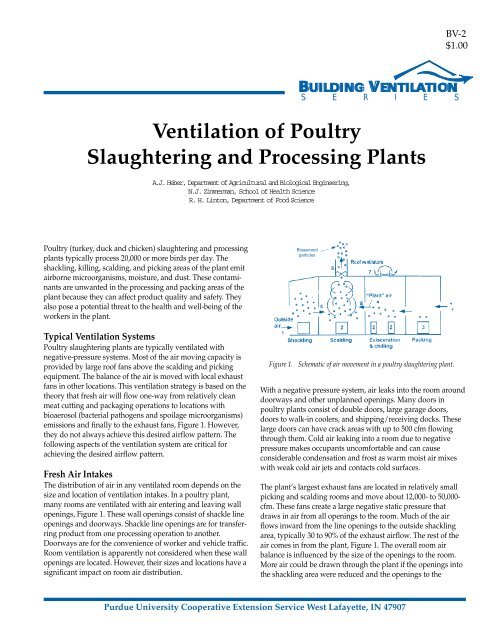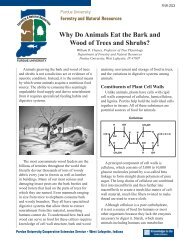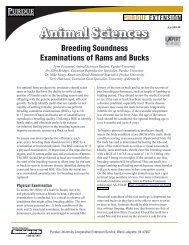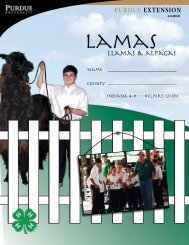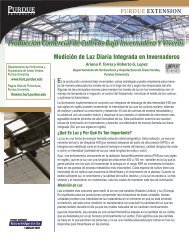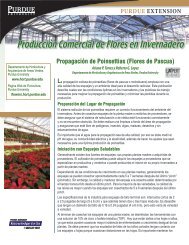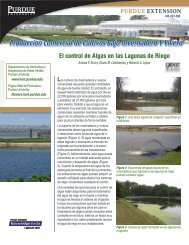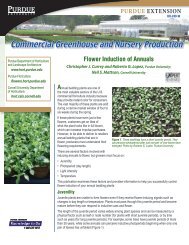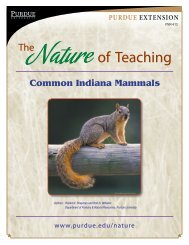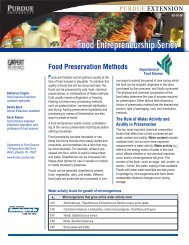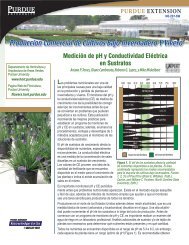Ventilation of Poultry Slaughtering and Processing Plants - Purdue ...
Ventilation of Poultry Slaughtering and Processing Plants - Purdue ...
Ventilation of Poultry Slaughtering and Processing Plants - Purdue ...
You also want an ePaper? Increase the reach of your titles
YUMPU automatically turns print PDFs into web optimized ePapers that Google loves.
BV-2<br />
$1.00<br />
BUILDING VENTILATION<br />
S E R I E S<br />
<strong>Ventilation</strong> <strong>of</strong> <strong>Poultry</strong><br />
<strong>Slaughtering</strong> <strong>and</strong> <strong>Processing</strong> <strong>Plants</strong><br />
<strong>Poultry</strong> (turkey, duck <strong>and</strong> chicken) slaughtering <strong>and</strong> processing<br />
plants typically process 20,000 or more birds per day. The<br />
shackling, killing, scalding, <strong>and</strong> picking areas <strong>of</strong> the plant emit<br />
airborne microorganisms, moisture, <strong>and</strong> dust. These contaminants<br />
are unwanted in the processing <strong>and</strong> packing areas <strong>of</strong> the<br />
plant because they can affect product quality <strong>and</strong> safety. They<br />
also pose a potential threat to the health <strong>and</strong> well-being <strong>of</strong> the<br />
workers in the plant.<br />
Typical <strong>Ventilation</strong> Systems<br />
<strong>Poultry</strong> slaughtering plants are typically ventilated with<br />
negative-pressure systems. Most <strong>of</strong> the air moving capacity is<br />
provided by large ro<strong>of</strong> fans above the scalding <strong>and</strong> picking<br />
equipment. The balance <strong>of</strong> the air is moved with local exhaust<br />
fans in other locations. This ventilation strategy is based on the<br />
theory that fresh air will flow one-way from relatively clean<br />
meat cutting <strong>and</strong> packaging operations to locations with<br />
bioaerosol (bacterial pathogens <strong>and</strong> spoilage microorganisms)<br />
emissions <strong>and</strong> finally to the exhaust fans, Figure 1. However,<br />
they do not always achieve this desired airflow pattern. The<br />
following aspects <strong>of</strong> the ventilation system are critical for<br />
achieving the desired airflow pattern.<br />
Fresh Air Intakes<br />
The distribution <strong>of</strong> air in any ventilated room depends on the<br />
size <strong>and</strong> location <strong>of</strong> ventilation intakes. In a poultry plant,<br />
many rooms are ventilated with air entering <strong>and</strong> leaving wall<br />
openings, Figure 1. These wall openings consist <strong>of</strong> shackle line<br />
openings <strong>and</strong> doorways. Shackle line openings are for transferring<br />
product from one processing operation to another.<br />
Doorways are for the convenience <strong>of</strong> worker <strong>and</strong> vehicle traffic.<br />
Room ventilation is apparently not considered when these wall<br />
openings are located. However, their sizes <strong>and</strong> locations have a<br />
significant impact on room air distribution.<br />
A.J. Heber, Department <strong>of</strong> Agricultural <strong>and</strong> Biological Engineering,<br />
N.J. Zimmerman, School <strong>of</strong> Health Science<br />
R. H. Linton, Department <strong>of</strong> Food Science<br />
Bioaerosol<br />
particles<br />
Figure 1. Schematic <strong>of</strong> air movement in a poultry slaughtering plant.<br />
With a negative pressure system, air leaks into the room around<br />
doorways <strong>and</strong> other unplanned openings. Many doors in<br />
poultry plants consist <strong>of</strong> double doors, large garage doors,<br />
doors to walk-in coolers, <strong>and</strong> shipping/receiving docks. These<br />
large doors can have crack areas with up to 500 cfm flowing<br />
through them. Cold air leaking into a room due to negative<br />
pressure makes occupants uncomfortable <strong>and</strong> can cause<br />
considerable condensation <strong>and</strong> frost as warm moist air mixes<br />
with weak cold air jets <strong>and</strong> contacts cold surfaces.<br />
The plant’s largest exhaust fans are located in relatively small<br />
picking <strong>and</strong> scalding rooms <strong>and</strong> move about 12,000- to 50,000cfm.<br />
These fans create a large negative static pressure that<br />
draws in air from all openings to the room. Much <strong>of</strong> the air<br />
flows inward from the line openings to the outside shackling<br />
area, typically 30 to 90% <strong>of</strong> the exhaust airflow. The rest <strong>of</strong> the<br />
air comes in from the plant, Figure 1. The overall room air<br />
balance is influenced by the size <strong>of</strong> the openings to the room.<br />
More air could be drawn through the plant if the openings into<br />
the shackling area were reduced <strong>and</strong> the openings to the<br />
<strong>Purdue</strong> University Cooperative Extension Service West Lafayette, IN 47907
evisceration room were enlarged. Consult a ventilation<br />
engineer for help in determining best opening sizes.<br />
Arbitrary Modifications<br />
The original ventilation system for a poultry processing plant<br />
is sometimes modified as rooms are added for more processing<br />
capacity. Additionally, exhaust fans are sometimes added<br />
in attempts to eliminate condensation. These exhaust fans can<br />
move air opposing the main exhaust fans in the picking <strong>and</strong><br />
scalding rooms. Air movement from clean areas to bioaerosol<br />
emission sources can be reversed if enough fans are added.<br />
(a)<br />
(b)<br />
Packing<br />
Figure 2. Hypothetical plant: a) before, <strong>and</strong> b) after arbitrary<br />
modifications to the ventilation system.<br />
Hypothetical Example<br />
A plant has three fans in the scalding room with a total<br />
capacity <strong>of</strong> 50,000 cfm, Figure 2a. However, 30,000 cfm is<br />
drawn through large line openings from the outdoor shackling<br />
area which is immediately adjacent to the scalding room.<br />
The remaining 20,000 cfm is drawn through line openings<br />
from the eviscerating room. Therefore, the original design<br />
causes 20,000 cfm to flow through the plant from the processing<br />
rooms to the eviscerating area <strong>and</strong> then to the scalding<br />
<strong>and</strong> picking room.<br />
A year later, the plant adds three, 4,000 cfm fans in the<br />
packaging room to eliminate moisture, <strong>and</strong> prevent condensation<br />
occurring on the ceiling. Two years later, new vacuum<br />
sources requiring 2,500 cfm are added to the processing areas,<br />
Figure 2b. Also, a 3,500 cfm exhaust system is added to a<br />
cooler room to remove carbon dioxide.<br />
2<br />
After these modifications, 18,000 cfm are exhausted at other<br />
locations besides the picking <strong>and</strong> scalding rooms. A major<br />
portion <strong>of</strong> this air comes from the evisceration room thus<br />
producing some reverse flow in the plant <strong>and</strong> causing an even<br />
greater portion <strong>of</strong> the air to flow into the picking <strong>and</strong> scalding<br />
rooms from the shackling area, Figure 2b.<br />
Fan Maintenance<br />
The fans <strong>and</strong> intakes in poultry meat plants are above the ro<strong>of</strong><br />
line <strong>and</strong> are easily ignored because most <strong>of</strong> the attention is<br />
given to the operation on the floor (“out <strong>of</strong> sight, out <strong>of</strong><br />
mind”). However, fan capacity can be reduced by up to 50%<br />
when the guards <strong>and</strong> backdraft shutters are laden with dust<br />
<strong>and</strong> feather material. Intakes can become completely plugged<br />
by particulate emissions from nearby exhaust fans. <strong>Ventilation</strong><br />
equipment maintenance should be a routine task <strong>of</strong> the plant<br />
maintenance crew.<br />
Multi-Purpose Rooms<br />
Air distribution should be taken into consideration when<br />
laying out processes within the room. Sometimes, “clean<br />
operations” for final product such as cutup <strong>and</strong> packaging are<br />
conducted in the same room as “dirty operations” such as<br />
evisceration. The “dirty operations” closer to the raw receiving<br />
area emit bioaerosols that can move to <strong>and</strong> deposit onto<br />
clean product. Thus, room air distribution is very important in<br />
preventing unnecessary food contamination.<br />
Fan Mismatches<br />
A food manufacturing plant may have several types <strong>and</strong> sizes<br />
<strong>of</strong> fans exhausting from the same room or adjoining rooms.<br />
High-pressure power ventilators, tube-axial fans, centrifugal<br />
fans, <strong>and</strong> vacuum systems sometimes operate in parallel with<br />
low-pressure propeller fans. As a consequence, weaker<br />
exhaust fans operate at reduced efficiency <strong>and</strong> air flow. Also,<br />
relatively moist air condenses on the inside <strong>of</strong> fan housings as<br />
air flow decreases. Additionally, air flow from areas with<br />
contamination sources to clean areas such as meat packaging<br />
may be created due to reverse flow. This increases product<br />
contamination <strong>and</strong> decreases food safety.<br />
In one case, about 5,000 cfm <strong>of</strong> air actually reversed through a<br />
large, belt-driven, exhaust fan running at slow speed in a<br />
feather wash room, Figure 3. This occurred because, in<br />
Figure 3. Example <strong>of</strong> fan mismatch in feather wash room.
addition to strong exhaust fans in adjoining rooms, a furnace<br />
with a high speed centrifugal fan exhausted air from the same<br />
room <strong>and</strong> blew hot air into the adjoining rooms via ductwork.<br />
The negative static pressure created by the furnace fan was<br />
felt by the slow moving fan as excessive back pressure. The<br />
airflow through the weak exhaust fan became positive again<br />
after the furnace was shut <strong>of</strong>f. To correct this situation, weak<br />
fans should be replaced with stronger or higher pressure fans.<br />
Or the speed <strong>of</strong> the weak fan should be increased. In this<br />
particular case, the supply air for the furnace could have been<br />
taken from another room.<br />
Effects <strong>of</strong> Wind Pressure<br />
Wind blowing into a large opening such as open doors or<br />
windows can pressurize a room causing undesired flow <strong>of</strong> air.<br />
In one case, air flowed through door cracks <strong>and</strong> other<br />
openings from a compressor <strong>and</strong> refrigeration room into a<br />
meat processing room when an overhead door was opened to<br />
“cool the compressors,” Figure 4a. The door was opened to an<br />
oncoming 12 mph wind even though the compressor room<br />
(a) (b)<br />
had its own exhaust ventilation system. Upon shutting the<br />
overhead door, the pressure in the compressor room became<br />
negative compared to that <strong>of</strong> the processing room <strong>and</strong> air<br />
flowed from the processing room to the compressor room, as<br />
desired, to keep contaminants away from clean product,<br />
Figure 4b.<br />
In another case, an overhead door in the picking room facing<br />
an 8-mph wind was opened on a hot summer day, Figure 5a.<br />
The resulting 18,000 cfm <strong>of</strong> air flowing inward through this<br />
door created high humidity <strong>and</strong> airborne microbial concentrations<br />
in the adjoining evisceration <strong>and</strong> processing room. The<br />
picking room was equipped with large exhaust fans, but the<br />
wind pressurized the “dirty” room in such as a way as to<br />
induce airflow into the “clean” room through some <strong>of</strong> the line<br />
openings between the two rooms, Figure 5a. Shutting the<br />
overhead garage door allowed the exhaust fans to create the<br />
negative pressure required to draw air through all openings<br />
from the evisceration <strong>and</strong> packing room, Figure 5b.<br />
Summary<br />
The emission <strong>of</strong> airborne particles with pathogenic <strong>and</strong><br />
spoilage microorganisms in poultry slaughtering <strong>and</strong> processing<br />
plants can create high airborne concentrations. It is<br />
important to keep these unwanted bioaerosols from processing<br />
<strong>and</strong> packing areas to assure product quality <strong>and</strong> safety <strong>and</strong><br />
the health <strong>and</strong> well-being <strong>of</strong> plant workers. The design <strong>of</strong><br />
ventilation systems is challenging because large airflows occur<br />
through shackle line openings between rooms <strong>and</strong> from the<br />
outdoors. However, careful design <strong>and</strong> maintenance <strong>of</strong> the<br />
ventilation system can prevent migration <strong>of</strong> airborne contamination<br />
from reaching clean areas <strong>of</strong> the plant.<br />
Figure 4. Effect <strong>of</strong> wind pressure on leaks into clean product area <strong>of</strong> the plant with garage door open (a) <strong>and</strong> closed (b).<br />
(a)<br />
Figure 5. Effect <strong>of</strong> wind pressure on airflow between dirty <strong>and</strong> clean rooms with garage door open (a) <strong>and</strong> closed (b).<br />
(b)<br />
3
4<br />
NEW 8/95 (.75M)<br />
Cooperative Extension work in Agriculture <strong>and</strong> Home Economics, state <strong>of</strong> Indiana, <strong>Purdue</strong> University, <strong>and</strong> U.S. Department <strong>of</strong> Agriculture<br />
cooperating; H. A. Wadsworth, Director, West Lafayette, IN. Issued in furtherance <strong>of</strong> the acts <strong>of</strong> May 8 <strong>and</strong> June 30, 1914. The <strong>Purdue</strong><br />
University Cooperative Extension Service is an equal opportunity/equal access institution.


